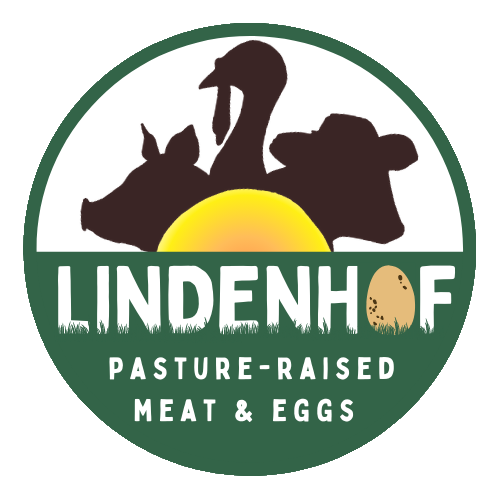Nutritional Information
Pasture-Raised Animals
Animals thrive in environments suited to their needs. Chickens and turkeys are naturally omnivors and feast on bugs, grubs, seeds and worms. They were not meant to feed on grain and corn while living in cramped quarters.
Pasture Environments are:
Better for the animals...eating what nature intended in the pasture
Better for the environment...harmony between the land & the animals
Better for farmers...living & working in a healthy sustainable atmosphere
Better for consumers...grassfed foods are lower in saturated fats & higher in essential nutrients.
They support overall good health.
Grass-fed Animal Products: Good for Animals, People, and the Planet
by Don Matesz
If you think the title of this article presents a contradiction in terms, please read on with an open mind. Contrary to popular beliefs, not all animal products are harmful to health, and not all animal husbandry is inhumane or un-ecological. The usual arguments against meat, eggs, and milk apply only to products that come from grain-fed animals or that are heavily processed (whether organic or not). Unprocessed products from 100 percent pasture-fed animals can be extremely healthful and humane.
It is a novel idea to most people, but the nutritional composition and health effects of any animal product depends entirely on the animals´ diet. None of the animals we raise for meat, eggs, or milk is naturally suited to a diet of corn and soybeans, not to mention the remains of other animals. Cattle are natural ruminants, designed to dine almost exclusively on fresh grass and other leaves; chickens are natural omnivores that thrive on fresh bugs, grubs, seeds, and worms.
Meats and milks from grass-fed animals also are nutritionally superior to grain-fed animal products. They contain far less total fat, less saturated fat, less omega-6 fat, and far more vitamins, minerals, and beneficial fats, including omega-3 fats (essential for cardiovascular and nervous system health) and conjugated linoleic acid (which stimulates fat metabolism, supports lean tissue health, and inhibits cancer cell development). Pasture-raised chickens, for example, produce meat and eggs high in vitamins, minerals, flavonoids, and omega-3 fatty acids but low in undesirable omega-6 fatty acids, whereas chickens fed organic corn and soy meal are comparatively much lower in vitamins, minerals, flavonoids, and omega-3 fatty acids, but much higher in omega-6 fatty acids.
Organic Is Not Good Enough
There is a vast difference between "organic" animal products, and grass-fed animal products. The label "organic" on an animal product means that the animals were raised without use of hormones, antibiotics, pesticides, or herbicides. Yet organically raised animals still may be fed dry grain diets, resulting in increased risk of transmissible gastrointestinal disease, unnatural fatty acid composition, and lower total nutrient value.
Organic grain-fed animal products just are not as nutritionally valuable as 100 percent grass-fed animal products. Further, since grain-feeding animals is not as ecological as grass-feeding them (see below), grass-fed products are environmentally preferable to organic grain fed products − even if they are not certified organic.
The Ecological Question
Some people suggest that animal products themselves are ecologically unsound. They argue that, for humans, a grain-based diet is friendlier to the earth; that raising food animals is a misuse of land; that enormous herds assist the process of global warming, groundwater loss and pollution, loss of species diversity, and depletion of fossil fuels.
This is certainly true when animals are fed a diet of grain. Grass feeding, however, does not impose row-cropping on the earth. Pasture land is naturally occurring, often in areas that are not suitable for food production. Only about one-third of the usable land on Earth (that is, about one-ninth of the total land mass) is suitable for growing crops. The remaining two-thirds of usable land supports growth only of plants that are not edible for humans, though they are edible for ruminants such as bison, cattle, deer, elk, zebra, eland, sheep, and goats.
Grazing ruminants do release methane into the atmosphere, and methane is one of the two major elements that contribute to global warming. Yet the grassy pastures on which they roam are 50 percent more effective than cultivated soils at removing carbon − the other element of global warming − from the atmosphere. The USDA Conservation Reserve Program has shown that when cultivated soils are returned to pasture, they gain an average of one-half ton of carbon per acre per year for the first five years after grassland restoration. As we combat global warming, it might actually be beneficial to return lands currently used for row-cropping to pasture!
Compared to cultivated lands, properly managed pasture lands make practically no contribution to soil erosion, ground water loss, or water pollution. They produce dense root structures that prevent erosion, enable the soil to retain water, refill subterranean aquifers, and protect surface waterways. In fact, incorporating grazing land into a farm is one of the most effective ways for a farmer to reduce erosion and water pollution (as well as diversify sources of income for more economic security).
Support Local Family Farms
Best of all, perhaps, pasture-based animal husbandry is best suited for small family farms as opposed to large-scale, transcontinental agribusiness. Because fresh meat, eggs, and milk from pasture raised animals are perishable, they are best obtained locally, from someone you can visit yourself. And small, family farms become more ecological and economically viable if their production is diversified to include animals. In fact, animals are essential to a truly sustainable farm design.
Pasture-based food, then, is not merely defensible, but positive for the planet. It is not simply acceptable, but positively healthful for human beings. It is a way to eat well, support local farming, and live in closer harmony with nature. Give up some of your assumptions, and give it a try!
The above article is a condensed version of the article found in the Conscious Choice Magazine and is offered with permission from the author, Don Matesz. Click here for the full version. Don is also co-author ofwww.TheGardenOfEatingDiet.com.
